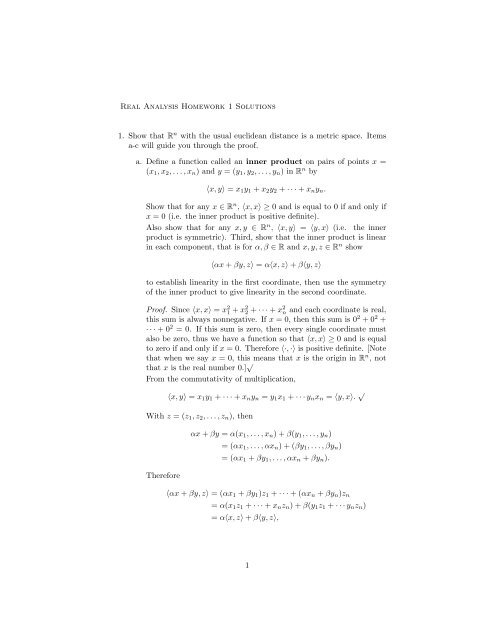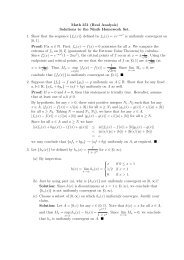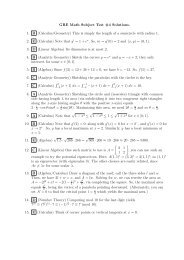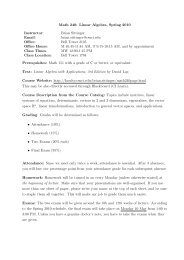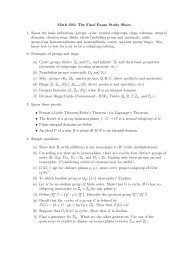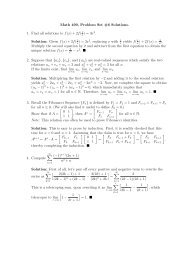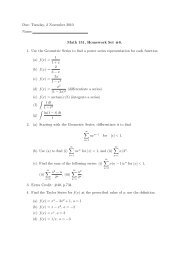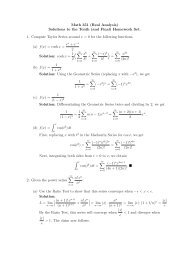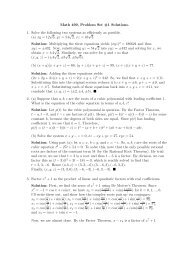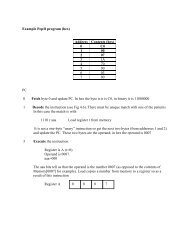Real Analysis Homework 1 Solutions 1. Show that Rn with the usual ...
Real Analysis Homework 1 Solutions 1. Show that Rn with the usual ...
Real Analysis Homework 1 Solutions 1. Show that Rn with the usual ...
You also want an ePaper? Increase the reach of your titles
YUMPU automatically turns print PDFs into web optimized ePapers that Google loves.
<strong>Real</strong> <strong>Analysis</strong> <strong>Homework</strong> 1 <strong>Solutions</strong><strong>1.</strong> <strong>Show</strong> <strong>that</strong> R n <strong>with</strong> <strong>the</strong> <strong>usual</strong> euclidean distance is a metric space. Itemsa-c will guide you through <strong>the</strong> proof.a. Define a function called an inner product on pairs of points x =(x 1 , x 2 , . . . , x n ) and y = (y 1 , y 2 , . . . , y n ) in R n by〈x, y〉 = x 1 y 1 + x 2 y 2 + · · · + x n y n .<strong>Show</strong> <strong>that</strong> for any x ∈ R n , 〈x, x〉 ≥ 0 and is equal to 0 if and only ifx = 0 (i.e. <strong>the</strong> inner product is positive definite).Also show <strong>that</strong> for any x, y ∈ R n , 〈x, y〉 = 〈y, x〉 (i.e. <strong>the</strong> innerproduct is symmetric). Third, show <strong>that</strong> <strong>the</strong> inner product is linearin each component, <strong>that</strong> is for α, β ∈ R and x, y, z ∈ R n show〈αx + βy, z〉 = α〈x, z〉 + β〈y, z〉to establish linearity in <strong>the</strong> first coordinate, <strong>the</strong>n use <strong>the</strong> symmetryof <strong>the</strong> inner product to give linearity in <strong>the</strong> second coordinate.Proof. Since 〈x, x〉 = x 2 1 + x 2 2 + · · · + x 2 n and each coordinate is real,this sum is always nonnegative. If x = 0, <strong>the</strong>n this sum is 0 2 + 0 2 +· · · + 0 2 = 0. If this sum is zero, <strong>the</strong>n every single coordinate mustalso be zero, thus we have a function so <strong>that</strong> 〈x, x〉 ≥ 0 and is equalto zero if and only if x = 0. Therefore 〈·, ·〉 is positive definite. [Note<strong>that</strong> when we say x = 0, this means <strong>that</strong> x is <strong>the</strong> origin in R n , not<strong>that</strong> x is <strong>the</strong> real number 0.] √From <strong>the</strong> commutativity of multiplication,〈x, y〉 = x 1 y 1 + · · · + x n y n = y 1 x 1 + · · · y n x n = 〈y, x〉. √With z = (z 1 , z 2 , . . . , z n ), <strong>the</strong>nThereforeαx + βy = α(x 1 , . . . , x n ) + β(y 1 , . . . , y n )= (αx 1 , . . . , αx n ) + (βy 1 , . . . , βy n )= (αx 1 + βy 1 , . . . , αx n + βy n ).〈αx + βy, z〉 = (αx 1 + βy 1 )z 1 + · · · + (αx n + βy n )z n= α(x 1 z 1 + · · · + x n z n ) + β(y 1 z 1 + · · · y n z n )= α〈x, z〉 + β〈y, z〉,1
which establishes linearity in <strong>the</strong> first variable. To get linearity in<strong>the</strong> second, let α, β ∈ R and x, y, z ∈ R n . Then using <strong>the</strong> symmetryof 〈·, ·〉 and <strong>that</strong> it’s linear in <strong>the</strong> first variable,〈x, αy + βz〉 = 〈αy + βz, x〉= α〈y, x〉 + β〈z, x〉= α〈x, y〉 + β〈x, z〉.Therefore it is linear in <strong>the</strong> second variable, too.b. For x ∈ R n define <strong>the</strong> norm of x by‖x‖ = 〈x, x〉 1 2 .Note <strong>that</strong> this gives <strong>the</strong> standard euclidean distance in R n of x from<strong>the</strong> origin.We now establish <strong>the</strong> Cauchy-Schwarz-Bunyakovsky inequality:|〈x, y〉| ≤ ‖x‖‖y‖.This is a significant inequality, and is essential in <strong>the</strong> study of innerproduct spaces.Let λ ∈ R and x, y ∈ R n . Consider <strong>the</strong> inequality from positivedefiniteness〈λx + y, λx + y〉 ≥ 0.Use linearity and symmetry to rewrite this as〈x, x〉λ 2 + 2〈x, y〉λ + 〈y, y〉 ≥ 0.Think of this as a quadratic in <strong>the</strong> variable λ, and since <strong>the</strong> left sideis always nonnegative, <strong>the</strong> discriminant in <strong>the</strong> quadratic formula isnonpositive, so <strong>that</strong>From this deduce <strong>that</strong>Proof. For λ ∈ R and x, y ∈ R n ,4〈x, y〉 2 − 4〈x, x〉〈y, y〉 ≤ 0.|〈x, y〉| ≤ ‖x‖‖y‖.0 ≤ 〈λx + y, λx + y〉= λ〈x, λx + y〉 + 〈y, λx + y〉= λ 2 〈x, x〉 + λ〈x, y〉 + λ〈y, x〉 + 〈y, y〉= λ 2 〈x, x〉 + 2λ〈x, y〉 + 〈y, y〉. √2
By considering this as a quadratic in <strong>the</strong> variable λ and <strong>that</strong> it isalways nonnegative, it ei<strong>the</strong>r has a repeated real root or no real rootsat all. Therefore <strong>the</strong> discriminant in <strong>the</strong> quadratic formula must beat most 0, i.e. b 2 − 4ac ≤ 0. This translates toThis leads to(2〈x, y〉) 2 − 4〈x, x〉〈y, y〉 ≤ 0.4|〈x, y〉| 2 ≤ 4〈x, x〉〈y, y〉,which by taking square roots and substituting in ‖ · ‖ where appropriate,|〈x, y〉| ≤ ‖x‖‖y‖.c. Define <strong>the</strong> function d(x, y) = 〈x − y, x − y〉 1 2 . We show <strong>that</strong> d is ametric on R n .i. <strong>Show</strong> <strong>that</strong> d is positive definite.ii. <strong>Show</strong> <strong>that</strong> d is symmetric.iii. Consider three points x, y, z ∈ R n . Since R n is a linear space and<strong>that</strong> in <strong>the</strong> function d we are considering differences of points, wemay assume y = 0 for simplicity, so x − y = x and y − z = −z.With this simplification, we have d(x, y) = ‖x‖ and d(y, z) = ‖z‖.<strong>Show</strong> <strong>that</strong>d(x, z) 2 = ‖x‖ 2 − 2〈x, z〉 + ‖z‖ 2 .Using <strong>the</strong> Cauchy-Schwarz inequality, show <strong>that</strong>d(x, z) 2 ≤ ‖x‖ 2 + 2‖x‖‖z‖ + ‖z‖ 2 .Taking square roots, conclude <strong>that</strong>d(x, z) ≤ ‖x‖ + ‖z‖ = d(x, y) + d(y, z).Hence, R n is a metric space using <strong>the</strong> metric derived from <strong>the</strong> innerproduct.Proof. We prove <strong>the</strong> positive definiteness of d since 〈w, w〉 ≥ 0 andis equal to zero if and only if w = 0. The form 〈w, w〉 1 2 also has thisproperty. By replacing w <strong>with</strong> x − y establishes <strong>that</strong> d is positivedefinite. √Symmetry is attained by using linearity in both components andobservingd(y, x) 2 = 〈y − x, y − x〉= 〈−(x − y), −(x − y)〉= − − 〈x − y, x − y〉= 〈x − y, x − y〉= d(x, y) 2 √3
For <strong>the</strong> triangle inequality, let x, y, z ∈ R n . If we define x ′ = x − y,y ′ = 0, z ′ = z −y, by definition, d(x ′ , y ′ ) = d(x, y), d(y ′ , z ′ ) = d(y, z),and d(x ′ , z ′ ) = d(x, z), <strong>the</strong>n we are able to use x ′ , y ′ , z ′ in place ofx, y, z. Therefore we may assume <strong>with</strong>out loss of generality <strong>that</strong>y = 0. Then d(x, y) = ‖x‖ and d(y, z) = ‖z‖.Consider <strong>the</strong> following calculation:d(x, z) 2 = 〈x − z, x − z〉= 〈x, x〉 − 〈x, z〉 − 〈z, x〉 + 〈z, z〉= ‖x‖ 2 − 2〈x, z〉 + ‖z‖ 2≤ ‖x‖ 2 + 2|〈x, z〉| + ‖z‖ 2≤ ‖x‖ 2 + 2‖x‖‖z‖ + ‖z‖ 2= (‖x‖ + ‖z‖) 2 .= (d(x, y) + d(y, z)) 2So we arrive at d(x, z) 2 ≤ (d(x, y) + d(y, z)) 2 , and by taking squareroots we get d(x, z) ≤ d(x, y) + d(y, z).d. Given any real vector space V , if <strong>the</strong>re is a function 〈·, ·〉 which satisfiesi. 〈x, x〉 ≥ 0, and 〈x, x〉 = 0 if and only if x = 0 (positive definiteness),ii. 〈x, y〉 = 〈y, x〉 (symmetry), andiii. 〈αx + βy, z〉 = α〈x, z〉 + β〈y, z〉 for all α, β ∈ R and x, y, z ∈ V ,<strong>the</strong>n we say V is a real inner product space. The Cauchy-Schwarzinequality follows from <strong>the</strong>se axioms, so V becomes a metric spaceunder <strong>the</strong> metric d(x, y) = 〈x − y, x − y〉 1 2 .If we want to consider complex vector spaces we have to change thingsa slight bit. First, we have to make sure <strong>the</strong> function respects complexlinearity, so we must consider α, β ∈ C instead of <strong>the</strong> reals. Second,<strong>the</strong> symmetric property must account for <strong>the</strong> complex variables aswell. So we replace ii. <strong>with</strong>ii. 〈x, y〉 = 〈y, x〉.so V equipped <strong>with</strong> such a function is a complex inner productspace.e. There are a lot of inner product spaces out <strong>the</strong>re. For example C[0, 1]is a real (complex) inner product space <strong>with</strong> inner product〈f, g〉 =∫ 10(f(x)g(x) dx =∫ 10)f(x)g(x) dx .4
f. There are a lot of spaces which are not inner product spaces. Forexample, <strong>the</strong> metrics d 1 and d ∞ on R 2 do not come from inner products.Similarly, <strong>the</strong> metrics d 1 and d ∞ on C[0, 1] don’t come from innerproducts.2. Given a metric space (X, d) define a function d ′ : X × X → R byd ′ (x, y) =d(x, y)1 + d(x, y) .a. <strong>Show</strong> <strong>that</strong> (X, d ′ ) is a metric space. Hint: When showing <strong>the</strong> triangleinequality, at some point you will have something like d(x, y)+d(y, z)in <strong>the</strong> denominator, and you replace this <strong>with</strong> d(x, z) which will make<strong>the</strong> fraction larger (but <strong>that</strong>’s ok since you’re showing an inequality).Proof. The function d ′ is positive definite since <strong>the</strong> function f(t) =t1+tis nonnegative on <strong>the</strong> nonnegative real numbers and is equal tozero exactly when t = 0.The function d ′ is symmetric sinced ′ (x, y) =d(x, y) d(y, x)=1 + d(x, y) 1 + d(y, x) = d′ (y, x).We show <strong>the</strong> triangle inequality for d ′ by starting <strong>with</strong> <strong>the</strong> triangleinequality for d. For simplicity, let a = d(x, z), b = d(x, y) andc = d(y, z). Thena ≤ b + ca + (ab + ac + abc) ≤ b + c + (ab + ac + abc)a + (ab + ac + abc) ≤ b + c + (ab + ac + abc) + (bc + abc + bc)a(1 + b)(1 + c) ≤ b(1 + a)(1 + c) + c(1 + a)(1 + b)a1 + a ≤ b1 + b + c1 + c ,where <strong>the</strong> second line arises from <strong>that</strong> adding equal amounts to eachside of an inequality preserves <strong>the</strong> inequality, <strong>the</strong> third line arises from<strong>that</strong> bc + abc + bc ≥ 0, <strong>the</strong> fourth line is algebra, and <strong>the</strong> fifth lineresults from division by <strong>the</strong> positive number (1 + a)(1 + b)(1 + c).3. <strong>Show</strong> <strong>that</strong> an arbitrary union of open sets is open.Proof. Let U α be open for every α ∈ A, where A is an index set. Letx ∈ U = ⋃ α∈A U α. Since U is a union, <strong>the</strong>re is some β ∈ A so <strong>that</strong>x ∈ U β . Thus <strong>the</strong>re is some r > 0 so <strong>that</strong> B r (x) ⊆ U β . Since U β ⊆ U,this implies B r (x) ⊆ U. Since x was an arbitrary element of U, this shows<strong>that</strong> U is open.5
4. Let X be a metric space and S ⊆ X. Prove <strong>that</strong> ext(S) = (X\S) ◦ .Proof. We show ext(S) = (X\S) ◦ by double containment.(⊆). Let x ∈ ext(S). Then <strong>the</strong>re some r > 0 so <strong>that</strong> B r (x) ∩ S = ∅. Using<strong>the</strong> same r, x is also a point in X\S so <strong>that</strong> B r (x) ⊆ X\S. Thereforex ∈ (X\S) ◦ .(⊇). Let x ∈ (X\S) ◦ . Then <strong>the</strong>re is some r > 0 so <strong>that</strong> B r (x) ⊆ X\S.Thus B r (x) ∩ S = ∅. But this shows <strong>that</strong> x ∈ ext(S).5. <strong>Show</strong> <strong>that</strong> R\Z is open in R.Proof. Let x /∈ Z be a real number. Then ⌊x⌋ < x⌊x⌋ + 1, where ⌊·⌋ is<strong>the</strong> greatest integer function. Let r = min{x − ⌊x⌋, ⌊x⌋ + 1 − x}. Thenfor y ∈ R, if |x − y| < r, <strong>the</strong>n y > ⌊x⌋ and y < ⌊x⌋ + 1, so y /∈ Z. HenceB r (x) ⊆ R\Z, so R\Z is open.Implicit in this argument is <strong>that</strong> <strong>the</strong> integers ⌊x⌋ and ⌊x⌋ + 1 are <strong>the</strong>two closest integers to x. The archimedean principle will show this to betrue.6. Prove <strong>that</strong> in R, ∂Q = R. Hint: between any two real numbers, <strong>the</strong>re isa rational.Proof. We want to show <strong>that</strong> for any x ∈ R and r > 0, <strong>the</strong>n B r (x) containsa point in Q and a point in R\Q.Case <strong>1.</strong> Let x ∈ R\Q and r > 0. Then <strong>the</strong>re is a rational q between x andx + r. Thus B r (x) contains a rational. This ball automatically containsx ∈ R\Q. Therefore x ∈ ∂Q.Case 2. Let x ∈ Q and r > 0. There is some rational q so <strong>that</strong> 0 < q < r.Then 0 < q π < r as well, and <strong>the</strong> number q πis irrational. Thus <strong>the</strong>irrational number x + q πis contained in B r(x). Thus any neighborhoodof x contains a rational (namely x) and an irrational. Therefore x ∈ ∂Q.Thus ∂Q = R in R.This proof also contains <strong>the</strong> idea <strong>that</strong> between any two reals <strong>the</strong>re is anirrational as well. This and <strong>the</strong> hint are consequences of <strong>the</strong> archimedeanprinciple.K&F 6.<strong>1.</strong> Give an example of a metric space R and two open spheres B r1 (x) andB r2 (y) in R such <strong>that</strong> B r1 (x) ⊆ B r2 (y) although r 1 > r 2 .Proof. Your example may be different. Let R be a nonempty discretemetric space, x = y ∈ R, and 0 < r 2 < r 1 < <strong>1.</strong> Then B r1 (x) = B r2 (x),and set containment follows from equality.For an example of strict containment, consider R = {(x, y) ∈ R 2 |x ≥0} ∪ {(−1, 0)}. Then B √ 2((−1, 0)) B 11 ((0, 0)). Note <strong>that</strong> you can’t get10strict containment if x = y.6


